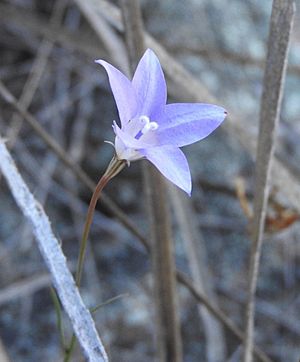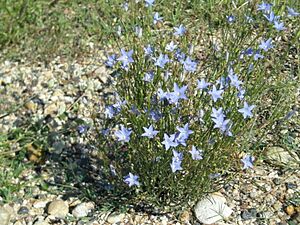Tufted bluebell facts for kids
Quick facts for kids Tufted bluebell |
|
|---|---|
 |
|
| Wahlenbergia capillaris in the Australian Capital Territory | |
| Scientific classification | |
| Genus: |
Wahlenbergia
|
| Species: |
capillaris
|
| Synonyms | |
The Wahlenbergia capillaris, often called the tufted bluebell, is a lovely plant with blue, bell-shaped flowers. It belongs to the Campanulaceae family. This plant grows naturally in Australia and New Guinea. It is a common sight, found across all mainland Australian states and territories. It grows upright and can reach about 50 cm (20 in) tall. Its leaves are mostly long and thin, sometimes with a few small teeth. The flowers have five petals and grow in clusters.
What the Tufted Bluebell Looks Like
The tufted bluebell is a perennial herb. This means it's a plant that lives for more than two years and has soft, green stems. It has a thick main root, called a taproot. From this root, many thin, straight, branched stems grow. The plant can reach about 50 cm (20 in) in height.
Its leaves are long and narrow, like a line. They are usually 4–50 mm (0.16–2.0 in) long and 0.5–6 mm (0.020–0.24 in) wide. Sometimes, the leaves grow along the stems, and sometimes they are mostly near the bottom of the plant. They often have a few small teeth along their edges.
The flowers are blue and grow in groups called cymes. Each flower has five sepals, which are small, leaf-like parts that protect the bud. These sepals are joined at the bottom. Their tips are narrow and triangular, about 2–6 mm (0.079–0.24 in) long.
The petals are also joined at the bottom, forming a narrow, bell-shaped tube. This tube is about 4–9 mm (0.16–0.35 in) long. The petal lobes (the parts that spread out) are shaped like ellipses or eggs. They are 6–15 mm (0.24–0.59 in) long and 2.5–6 mm (0.098–0.24 in) wide.
Inside the flower, there is a part called the style. It is about 4.5–9.5 mm (0.18–0.37 in) long and has three small lobes at its end. The tufted bluebell usually flowers between October and March. After flowering, it produces a fruit called a capsule. This capsule is oval or cone-shaped, about 4–9 mm (0.16–0.35 in) long and 1.5–5 mm (0.059–0.20 in) wide.
How the Tufted Bluebell Got its Name
The tufted bluebell has had a few different names over the years! It was first officially described in 1839 by a person named George Loddiges. He gave it the name Campanula capillaris. This description was published in a book called The Botanical Cabinet.
Later in the same year, another person named George Don changed its name to Wahlenbergia capillaris.
For a while, a botanist named Roger Charles Carolin thought Loddiges' first description wasn't clear enough. So, in 1965, Carolin gave the plant a new name: Wahlenbergia communis.
However, in 2016, Ian Mark Turner brought back Loddiges' original name. This change has now been accepted by important plant lists like the World Checklist of Selected Plant Families and the Australian Plant Census.
The second part of the plant's scientific name, capillaris, comes from a Latin word. It means "of hair," probably because of the plant's thin, hair-like stems.
Where the Tufted Bluebell Grows
The Wahlenbergia capillaris is very common and can be found all over mainland Australia. It also grows in New Guinea. You'll often see it in places where the ground has been disturbed, like along roadsides or in open fields.


